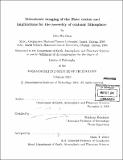Teleseismic imaging of the Slave craton and implications for the assembly of cratonic lithosphere
Author(s)
Chen, Chin-Wu, Ph. D. Massachusetts Institute of Technology.
DownloadFull printable version (13.40Mb)
Other Contributors
Massachusetts Institute of Technology. Dept. of Earth, Atmospheric, and Planetary Sciences.
Advisor
Stéphane Rondenay.
Terms of use
Metadata
Show full item recordAbstract
In this dissertation, I investigate the assembly and evolution of the Archean cratonic lithosphere by using two complementary seismological methods to image the lithospheric structure of the Slave craton in Canada. First, I perform surface wave tomographic inversions to constrain the depth dependence of Rayleigh wave phase velocity, shear wave velocity, and azimuthal anisotropy of the Slave cratonic lithosphere. The tomographic images reveal high shear wave velocities associated with a particularly depleted, cold, and unperturbed Archean cratonic lithosphere. Furthermore, the inversions reveal distinct anisotropic domains in the crust, the lithospheric mantle, and the sub-lithospheric mantle. These results reflect the evolutionary history of the cratonic lithosphere. Secondly, I image seismic discontinuities in the lithosphere using receiver-function analysis of converted P-to-S waves. The resulting seismic profile shows a pronounced low velocity discontinuity at -100 km depth beneath the central Slave craton. This seismic discontinuity shows striking spatial correlation with both an electrical conductive anomaly derived from magnetotelluric sounding, as well as a petrologically-defined ultra-depleted layer. The synthesis of coincident seismic, electrical, and petrological evidence supports that this geophysical and petrological boundary represents a compositional interface marked by alteration minerals. I suggest that this mineralization resulted from relict metasomatism associated with an Archean subduction event, which played an important role in the assembly of the Slave craton. Finally, to improve the efficiency and automation of receiver function calculation and data preprocessing workflow, I develop an application of an array-conditioned deconvolution technique for effectively processing large amounts of seismic array data. I demonstrate that this technique is readily applicable to teleseismic array data. This technique is especially effective in turning noisy traces from earthquakes with smaller magnitudes into usable data.
Description
Thesis (Ph. D.)--Massachusetts Institute of Technology, Dept. of Earth, Atmospheric, and Planetary Sciences, 2010. Cataloged from PDF version of thesis. Includes bibliographical references (p. 123-132).
Date issued
2010Department
Massachusetts Institute of Technology. Department of Earth, Atmospheric, and Planetary SciencesPublisher
Massachusetts Institute of Technology
Keywords
Earth, Atmospheric, and Planetary Sciences.